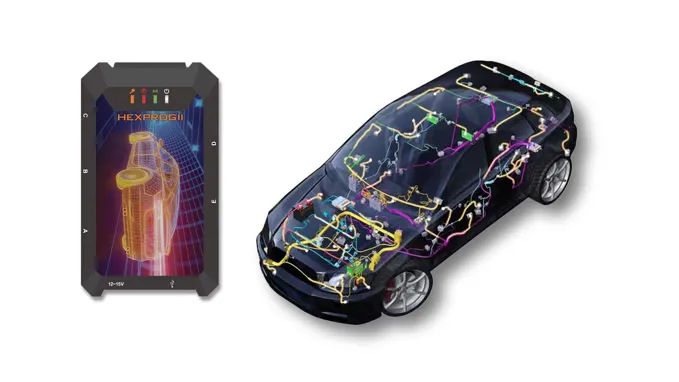Understanding the Engine Control Unit (ECU):
Key Components and Functions
The Engine Control Unit (ECU) is a pivotal component in modern vehicles, serving as the brain that orchestrates the intricate functions of the engine. It is responsible for managing critical aspects such as engine performance, emissions control, and overall fuel efficiency. As vehicles have evolved, so too has the complexity and sophistication of the ECU, reflecting advancements in automotive technology and the increasing demand for higher performance and lower emissions.
Understanding how the ECU operates is essential for anyone involved in vehicle maintenance, repair, or design. The ECU collects and processes data from various sensors placed throughout the vehicle, interpreting this information to make real-time adjustments to engine parameters. These adjustments ensure that the engine runs smoothly and efficiently under a wide range of operating conditions, from everyday driving to extreme performance situations.
At its core, the ECU is designed to optimize fuel consumption while minimizing harmful emissions. It continuously monitors factors such as air-fuel mixture, ignition timing, and exhaust conditions, adjusting the engine's operations to achieve the best possible performance. For instance, during acceleration, the ECU may alter the fuel injection rate to provide the necessary power while simultaneously managing emissions to meet regulatory standards.
As vehicles become more reliant on electronic systems, the ECU has also taken on additional roles beyond engine management. It often communicates with other control units in the vehicle, such as those responsible for transmission, anti-lock braking systems (ABS), and stability control. This interconnectivity allows for coordinated vehicle responses, enhancing safety and performance.
Moreover, advancements in technology have introduced features such as adaptive learning algorithms within the ECU. These algorithms allow the ECU to adjust its strategies based on driving patterns and environmental conditions, resulting in improved fuel efficiency and performance tailored to individual driving styles.
Improving ECU Performance with Hexprog II
Specific tools like Hexprog II play crucial roles in interfacing with the Engine Control Unit (ECU), each designed for distinct purposes. This particular tool is tailored for Background Debug Mode (BDM) tasks, enabling users to read from and write to a diverse array of EEPROMs. This functionality is essential for repairing module faults and cloning ECUs across multiple vehicle brands. By enhancing the ability to diagnose, program, and maintain the ECU, it underscores the increasing complexity of modern automotive electronics.
The Hexprog II version offers a multitude of benefits for ECU repair, making it indispensable for both automotive professionals and enthusiasts. Its user-friendly interface simplifies the repair process, ensuring accessibility for users of all skill levels. With broad vehicle support, it is compatible with a wide range of makes and models, providing versatile applications for various automotive needs.
Additionally, this tool delivers cost-effective solutions, presenting various repair and tuning options that can significantly save users money compared to traditional dealership services. This affordability makes it an attractive choice for those looking to maintain and enhance vehicle performance without incurring high costs.
One of its standout features is the ability to allow real-time adjustments to ECU parameters, boosting vehicle performance and addressing issues promptly. This capability is particularly valuable in today’s fast-paced automotive environment, where quick and efficient solutions are often required.
Moreover, remote assistance features enable users to access online updates and support, fostering continuous improvement in ECU management. This aspect not only enhances the user experience but also ensures that technicians are equipped with the latest tools and knowledge to tackle evolving automotive challenges.
Overall, this tool optimizes ECU performance and effectively resolves faults, reflecting the evolving sophistication of automotive technology. Its combination of user-friendliness, broad compatibility, cost savings, and real-time capabilities makes it a vital asset in the toolkit of anyone involved in automotive diagnostics and repair.
The Role of the ECU
The Engine Control Unit (ECU) serves as the brain of the vehicle, playing a critical role in optimizing engine performance through sophisticated data processing and control mechanisms. Its primary function is to gather and analyze information from various sensors strategically placed throughout the vehicle, enabling it to make real-time adjustments that enhance engine functionality.
One of the most important aspects of the ECU's role is its ability to interpret data from a multitude of sensors, including oxygen sensors, mass airflow sensors, throttle position sensors, and temperature sensors. Each of these components provides vital information about the engine's current state, such as the air-fuel mixture, engine temperature, and airflow. The ECU continuously monitors this data, allowing it to assess whether the engine is operating within its optimal parameters. By processing this information, the ECU can determine how best to adjust engine functions to maintain peak performance.
For instance, when a driver accelerates, the ECU responds by adjusting the fuel injection and ignition timing to ensure that the engine delivers the desired power. If the vehicle is climbing a steep hill, the ECU may modify these parameters even further to provide additional torque. This ability to adapt to different driving conditions is crucial for maintaining not only performance but also fuel efficiency.
Moreover, the ECU plays an essential role in ensuring that the engine complies with stringent environmental regulations regarding emissions. By continuously monitoring exhaust gases and adjusting the air-fuel mixture, the ECU minimizes the production of harmful pollutants. This function is particularly important in the context of global efforts to reduce vehicle emissions and combat climate change. Many modern ECUs are designed to comply with specific emission standards, utilizing advanced strategies such as closed-loop fuel control and exhaust gas recirculation.
In addition to optimizing performance and ensuring compliance with environmental regulations, the ECU enhances vehicle safety and reliability. By integrating with other vehicle control systems, the ECU can provide crucial data that influences overall vehicle dynamics. For example, in the event of sudden braking, the ECU may communicate with the anti-lock braking system (ABS) to prevent wheel lock-up, ensuring stable braking performance. This level of integration helps create a cohesive driving experience where all systems work in harmony.
The ECU’s role also extends to adaptive features that improve the overall driving experience. For example, many modern ECUs utilize machine learning algorithms that allow them to learn from driver behavior and adapt to individual driving styles. This capability means that over time, the ECU can optimize performance based on how a driver typically accelerates, brakes, and maneuvers, resulting in a more personalized driving experience.
Furthermore, the ECU is integral to vehicle diagnostics. It constantly monitors the health of the engine and associated systems, running self-checks to identify potential issues before they become serious problems. When a fault is detected, the ECU can trigger warning lights on the dashboard and store diagnostic trouble codes (DTCs), which mechanics can access for troubleshooting. This proactive approach to vehicle maintenance not only enhances reliability but also helps reduce long-term repair costs for vehicle owners.
Key Components of the ECU
- Microcontroller Unit (MCU)
- The MCU is the heart of the ECU, responsible for processing data from sensors and executing control algorithms. It enables real-time operations, ensuring the engine can adapt to changing conditions.
- Sensors
- Oxygen Sensors: Measure oxygen levels in the exhaust to optimize the air-fuel mixture.
- Mass Airflow Sensors: Gauge the amount of air entering the engine.
- Throttle Position Sensors: Monitor the position of the throttle pedal.
- Temperature Sensors: Track engine coolant and air intake temperatures.
- Actuators
- These components receive commands from the MCU to perform actions, such as:
- Fuel Injectors: Control the amount of fuel injected into the combustion chamber.
- gnition Coils: Manage the timing of spark plug activation.
- Idle Air Control Valves: Regulate engine idle speed.
- These components receive commands from the MCU to perform actions, such as:
- Power Supply Circuit
- This circuit provides the necessary voltage and current to the ECU and its components, ensuring reliable operation.
- Communication Interfaces
- CAN Bus Interface: Facilitates communication between the ECU and other vehicle control units, enabling coordinated actions.
- K-Line Interface: Primarily found in older vehicles, this interface enables communication for diagnostic purposes, allowing external diagnostic tools to connect and retrieve trouble codes and monitor real-time data.
- Diagnostic Port: Allows external diagnostic tools to connect for troubleshooting and programming, providing access to both K-Line and CAN bus systems in compatible vehicles.
- Memory
- Internal Flash Memory: Built into the MCU, this non-volatile memory stores essential firmware and calibration data (MAP Data) for real-time access, enabling the ECU to operate efficiently and perform self-diagnostics. It also includes areas for One Time Programming (OTP), which protects critical data from modification.
- One Time Programming (OTP) allows certain data or firmware to be written to memory only once, ensuring it cannot be modified or erased.
- External Flash Memory: Provides additional storage capacity for MAP Data updates and data logging. This flexibility allows for easier updates and enhances diagnostic capabilities.
- EEPROM (Electrically Erasable Programmable Read-Only Memory): A type of non-volatile memory used to store important data such as calibration settings, vehicle configurations, and diagnostic trouble codes (DTCs). EEPROM allows for frequent updates without needing to erase larger blocks of memory, complementing the functions of internal and external flash memory.
- Internal EEPROM: is integrated directly within the microcontroller unit (MCU) of the ECU. Commonly used to store essential calibration data, vehicle configurations, and diagnostic trouble codes (DTCs) that need to be updated frequently.
- External EEPROM: is a separate chip connected to the ECU, providing additional storage outside the MCU. Used for more extensive datasets that may require frequent updates, such as detailed calibration data or additional vehicle settings.
- EEPROM (Electrically Erasable Programmable Read-Only Memory): A type of non-volatile memory used to store important data such as calibration settings, vehicle configurations, and diagnostic trouble codes (DTCs). EEPROM allows for frequent updates without needing to erase larger blocks of memory, complementing the functions of internal and external flash memory.
- Internal Flash Memory: Built into the MCU, this non-volatile memory stores essential firmware and calibration data (MAP Data) for real-time access, enabling the ECU to operate efficiently and perform self-diagnostics. It also includes areas for One Time Programming (OTP), which protects critical data from modification.
- Analog-to-Digital Converters (ADC)
- These converters transform analog signals from sensors into digital data for the MCU to process.
- Power Management Circuitry
- Manages power distribution and protects the ECU from voltage spikes and other electrical issues.
- Safety Features
- Checksum: A calculated value used to verify data integrity during transmission or storage. It helps detect errors by comparing the original checksum with a recalculated value. In ECUs, checksums ensure that firmware and calibration data are intact, preventing potential malfunctions caused by corrupted data.
- Watchdog Timer: Monitors the MCU’s operation to prevent lock-ups or failures.
- Redundant Systems: Some ECUs feature backup systems to ensure continued operation in case of a failure.
- Input/Output Interfaces
- Facilitate connections to various sensors and actuators, allowing the ECU to interact with the vehicle’s systems.
Key Benefits of HEXPROG II on ECUs
Hexprog II is expertly designed to support a wide range of communication protocols, making it a versatile ECU Programming Tool for automotive programming across various vehicles. Its compatibility with both K-Line and CAN bus systems allows technicians to service everything from older models to the latest cars, ensuring broad coverage and flexibility for every type of vehicle.
Hexprog II enhances diagnostic and programming processes by providing comprehensive support for trouble code retrieval, and access to manufacturer-specific parameters. This capability enables technicians to diagnose complex issues with precision and efficiency, making it an essential tool for ECU cloning and repairs.
Additionally, Hexprog II simplifies ECU Programming tasks, whether it’s updating software, or performing custom Chip Tuning. Thanks to its user-friendly interface, the tool streamlines the entire process, reducing the complexity typically associated with these tasks. Hexprog II is continuously updated to keep up with the latest automotive technologies, ensuring technicians always have access to the most current features and protocols.
One of Hexprog II’ s standout features is its extensive EEPROM support, which allows technicians to read and write data across a wide array of EEPROMs. This capability makes Hexprog II a powerful tool for automotive engineers, as it supports various EEPROM types across multiple vehicle brands. With Hexprog II, users can efficiently perform tasks such as:
- Reading Data: Extracting configuration settings or calibration data from the EEPROM for analysis or backup of Flash and EEPROM.
- Writing Data: Updating or modifying settings in the EEPROM and Flash to reflect changes in vehicle configuration or performance requirements.
- Cloning ECUs: Facilitating the duplication of electronic control units (ECUs) by transferring EEPROM and flash data from one unit to another, ensuring compatibility and functionality.
With its comprehensive data management capabilities, Hexprog II enhances the diagnostic and ECU Programming process, making it an essential tool for handling modern automotive electronics.
For performance tuning, Hexprog II goes beyond basic ECU Programming tasks with its powerful Chip Tuning Tool. Hexprog II Chip Tuning tool enables technicians and enthusiasts to modify engine control units for optimal performance. Whether it’s adjusting power output, fuel efficiency, or fine-tuning specific engine parameters, Hexprog II offers flexibility for all levels of tuning needs.
Hexprog II, the advanced version of this tool, takes things even further by automating the checksum calculation process. This feature is particularly beneficial for technicians, as it eliminates the need for manual checksum calculations, which can often lead to errors. Hexprog II ensures the accuracy and integrity of data being written to the ECU, guaranteeing the firmware or calibration data is transferred correctly and completely.
The checksum serves as a verification method when programming or updating an ECU. If the checksum matches the original value, it confirms that the data has been transmitted correctly without corruption. If there’s a mismatch, it signals an error during the transfer/writing process of Flash data, which could cause system malfunctions or performance issues.
This automatic checksum calculation feature is vital for maintaining ECU functionality. Without proper verification, corrupted data could result in instability, performance degradation, or even make the vehicle inoperable. By integrating this feature, Hexprog II ensures that any modifications made to the ECU will enhance its operation rather than compromise it.
With Hexprog II as your ECU Programming Tool and Chip Tuning Tool, you can rely on the most advanced, accurate, and efficient method for working with modern automotive ECUs. These features not only help technicians optimize vehicle performance but also ensure reliability and safety, making Hexprog II an indispensable tool for automotive professionals and enthusiasts alike.
This version integrates the ECU Programming Tool and Hexprog II Chip Tuning Tool seamlessly into the article, showcasing how these features enhance the tool’s versatility and appeal to automotive professionals who require both diagnostic and performance tuning capabilities.
The Processor: Key to ECU Functionality and Performance
The processor within the ECU is integral to its operation. It processes incoming data from sensors, runs control algorithms, and manages communication with other vehicle systems. Its real-time capabilities are crucial for adjusting engine parameters quickly and efficiently, maintaining optimal performance and fuel economy.
The processor in an Engine Control Unit (ECU) is a critical component that plays a central role in its functionality. Here’s a closer look at the processor’s role and importance:
- Data Processing
The processor (often part of the microcontroller) interprets data from various sensors in real-time. It executes complex algorithms to make decisions regarding engine management, optimizing performance and efficiency. - Control Algorithms
It runs control algorithms that determine how to adjust fuel injection, ignition timing, and other engine parameters based on sensor inputs and operational conditions. - Real-Time Operations
Designed for real-time performance, the processor must execute tasks within strict timing constraints to ensure the engine operates smoothly. This responsiveness is crucial during acceleration, deceleration, and varying driving conditions. - Adaptive Learning
The processor can implement adaptive learning algorithms that allow the ECU to adjust its strategies over time based on driving patterns, fuel quality, and environmental conditions. - Communication Management
It manages communication with other control units and devices via protocols like CAN, enabling coordinated operation of various vehicle systems. - Diagnostic Functions
The processor executes self-diagnostic routines to monitor system performance, detect faults, and log diagnostic trouble codes (DTCs) for troubleshooting. - Memory Access
It handles access to both flash memory (for software and calibration data) and RAM (for temporary data storage), ensuring efficient operation. - Safety and Reliability
Many processors include safety features, such as error detection and correction, to ensure reliable operation even in the event of faults. - Integration with Other Components
The processor interfaces with other essential components, like analog-to-digital converters (ADCs), to process sensor data and control actuators effectively.
In summary, the processor is the brain of the ECU, executing the necessary computations and control functions to manage engine performance, ensure efficiency, and maintain emissions standards. Its capabilities directly influence the overall effectiveness of the engine control system.
Conclusion
In conclusion, the Engine Control Unit (ECU) is an essential component in modern vehicles, orchestrating the intricate functions of the engine to optimize performance, ensure compliance with emissions standards, and enhance overall driving experience. By processing data from various sensors and making real-time adjustments, the ECU enables efficient fuel consumption and reduced harmful emissions. The integration of advanced tools like and HexprogII further enhances the capabilities of the ECU, providing automotive professionals with powerful solutions for diagnostics, programming, and repairs. These tools streamline complex tasks, support a wide range of vehicle makes and models, and facilitate real-time adjustments, all while ensuring cost-effective solutions. As automotive technology continues to evolve, understanding the ECU's functions and utilizing advanced tools will be crucial for maintaining vehicle performance and reliability.



